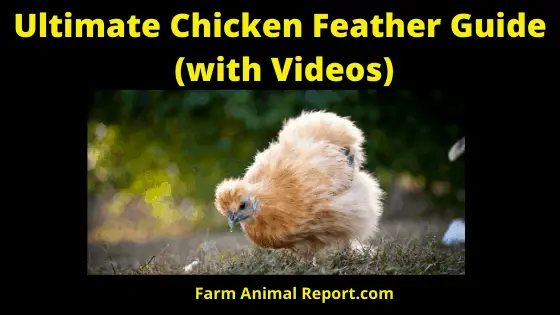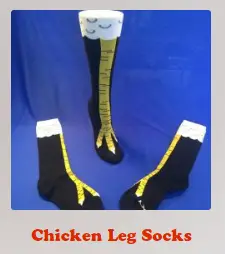Do Chickens Have Hair?
As a general rule Feathers are unique to birds and are the protective outer covering of chickens and serve three important purposes. To help keep the birds at the right temperature and afford protection to the body from rain and injury. They enable flight and serve as a display for courtship and for the fancier to show. Feathers are poor conductors of heat so insulate the chicken well against the cold.
3 Types of Feathers
- Normal
- Grizzled
- No Quills
Why Do Chickens Wings have Hair – There are three main types of feathers, normal, grizzled, and no quills (as in the silkie). They are waterproof to an extent but a chicken will not stay dry like a duck would for example. The feathers of the male are usually more vivid, showy, and brilliant than those of the hen. Feathers are the product of many hundreds of thousands of years of evolution and enable the chicken to fly. Do Chickens Have Hair
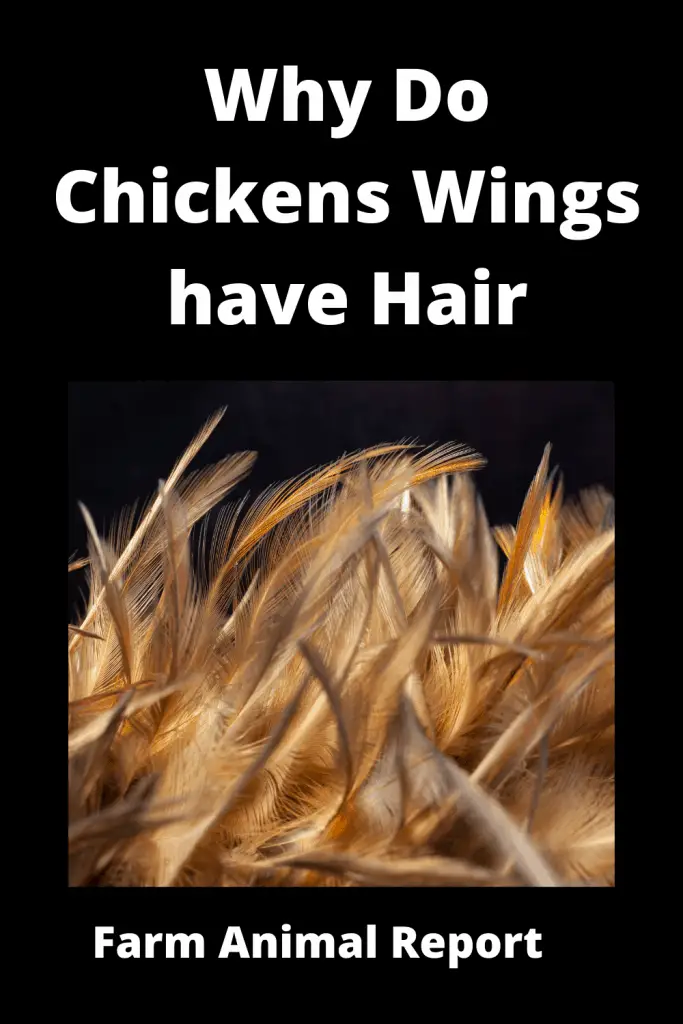
They grow back in a similar way to hair if they fall out or are plucked out. Patterns and markings keep them and their offspring camouflaged, keep the bird warm in winter by trapping air next to the body to insulate the chicken and they keep the sun off the tender skin and keep the temperature down in hot sunny situations.
12 Ways to Make Money by Chicken Farming—Extensive Guidelines for Chicken Farmers
If you exclude the heads of some vultures and the Transylvanian naked necks, birds are covered with feathers and the humble chicken is no different. The average chicken has dozens of different types of feathers, all adapted to different uses.
See Amazons Educational Resources for Chicken Diseases
8 Design Uses of Feathers
- Flying; Even though chickens are not the best flyers, they can fly and this is the main purpose of the flight feathers. Feathers provide a large surface area on the wings for powered flight, on the tail for maneuverability, and all over the body for a streamlined shape. The aerodynamics of the feather allows the bird to fly and maneuver in the air.
- Insulation; They trap air next to the skin and keep the bird warm in winter and cool in summer. They also provide a barrier to the wind and sun and protect the delicate skin.
- Waterproofing; Feathers can shed off an amazing amount of water. Especially ducks, hence that saying ‘water off a duck back’.
- Camouflage; With wild birds and the pattern of some species of feathers help the birds to blend in with their surroundings.
- Protection; They help protect the skin against all manner of weather and insects.
- Courtship and display; Chickens do not really use their feathers for courtship or display like a peacock would, for example. In many avian species, the color and use of plumage in courtship displays will determine who gets to mate. More often than not with chickens, it is the keeper that chooses the mating flock.
- Sensations; There are structures called Herbst’s corpuscles at the base of the feather which is thought to be able to detect changes in the air current and sound vibration.
- Show; Humans have bred chickens to have all sorts of different feather patterns for showing.
Feathers evolved over considerable time and their uses to the bird are numerous being both incredibly strong yet lightweight, only 3% to 4% of the total weight of the bird is feathers depending on the breed and size. Feathers cover most of the chicken’s body.
Most breeds of chickens have bare legs, but some have feathers growing down their legs and even on their toes. Other variations of feathering include muffs, puffs of feathers around the ear lobes; beards, long, hanging feathers beneath the beak; and crests or topknots, poofs of feathers on the head that may fall down and cover the eyes.
Hard Feathered / Soft Feathered
Some breeds of chickens appear fluffy, and some appear smooth and sleek. Chickens with smooth, sleek feathers are called hard-feathered, and birds with loose, fluffy feathers are called soft-feathered.
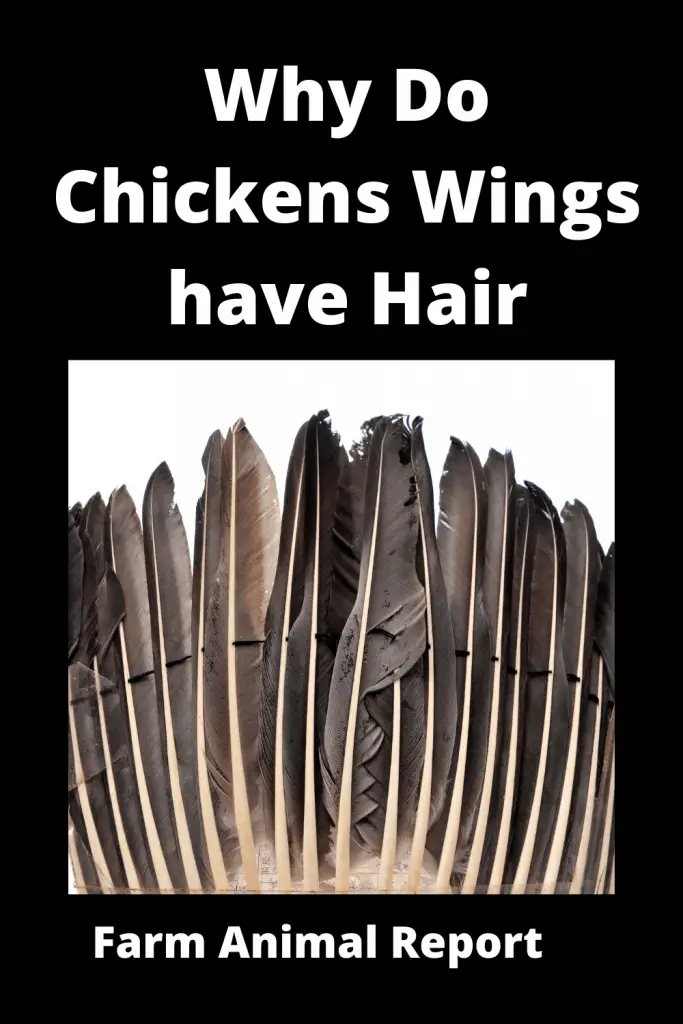
Frizzles – Feathers
A feather mutation can cause the shaft of the feather to curl or twist, making the feathers on the birds stick out all over in a random fashion. Talk about your bad hair day! These birds are called Frizzles.
The Frizzle mutation can occur in a number of chicken breeds.
Feather Molting – 7 Weeks
Birds shed their feathers, beginning with the head feathers, once a year, usually in the fall. This shedding period is called the molt, and it takes about 7 weeks to complete. The molting period is stressful for chickens.
Types of Feathers
- Contour
- Down
- Wing
- Tail
Contour feathers are the outer feathers that form the bird’s distinctive shape. They include a wing and tail feathers and most of the body feathers. Down feathers are the layer closest to the body. They provide insulation from cold temperatures.
Down feathers lack the barbs and strong central shaft that the outer feathers have, so they remain fluffy. Silkie chickens have body feathers that are as long as the feathers of normal chickens, but their outer feathers also lack barbs, so the Silkie chicken looks furry or fluffy all over.
Feathers also vary according to what part of the chicken they cover. The following list associates these various types of feathers with the chicken’s anatomy:
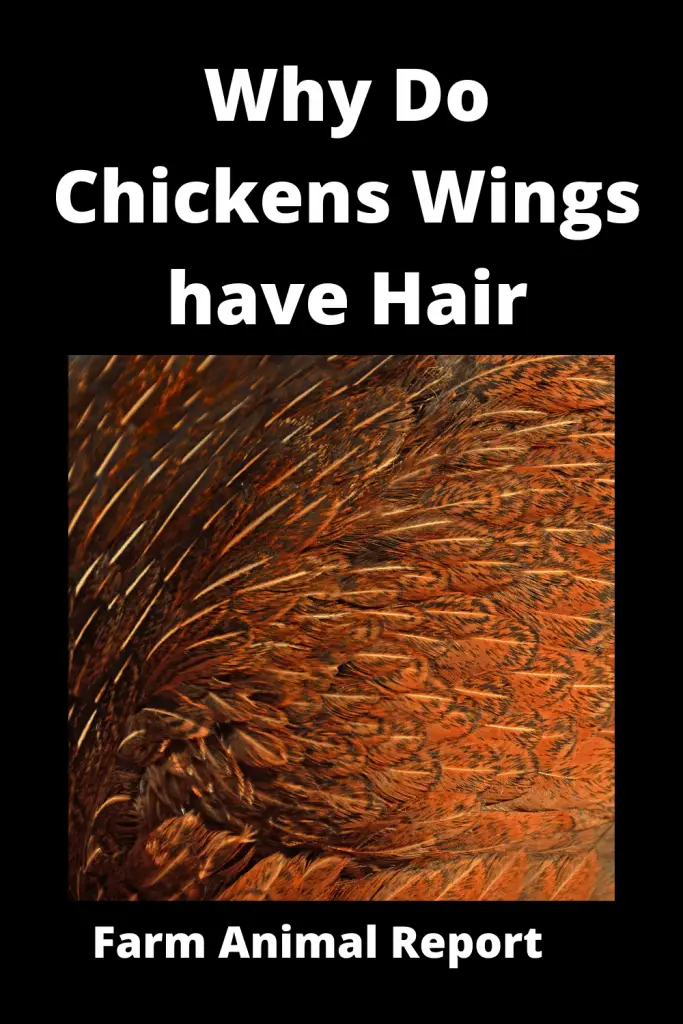
Feather Locations
- On the neck; The row of narrow feathers around the neck constitutes the hackles. Hackle feathers can stand up when the chicken gets angry. These feathers are often a different color than the body feathers, and they may be very colorful in male birds. In most male chickens, the hackle feathers are pointed and iridescent. Female hackle feathers have rounded tips and are duller.
- On the belly and midsection; The belly and remaining body areas of the chicken are covered with small, fluffy feathers. In many cases, the underside of the bird is lighter in color.
- On the wings; Chickens have three types of feathers on the wings. The top section, closest to the body, consists of small, rounded feathers called coverts. The middle feathers are longer and are called secondaries. The longest and largest feathers are on the end of the wing and are called primaries. Each section overlaps the other just slightly.
- On the legs; Chicken thighs are covered with soft, small feathers. In most breeds, the feathers end halfway down the leg, at the hock joint. In some breeds, however, the legs have fluffy feathers right down to and covering the toes.
- On the tail; Roosters have long, shiny, attractive tail feathers. In many breeds, the top three or four tail feathers are narrower and may arch above the rest of the tail. These are called sickle feathers. Hens have tail feathers, too, but they are short and plainly colored, and they don’t arch.
Anatomy of Feathers
Feathers are made of keratin, the same stuff that comprises your fingernails and hair. Each feather has a hard, central, stem-like area called a shaft. The bottom of the mature shaft is hollow where it attaches to the skin and is called a quill.
Immature feathers have a vein in the shaft, which will bleed profusely if the feather is cut or torn.
Immature feathers are also called pinfeathers because when they start growing, they are tightly rolled and look like pins sticking out of the chicken’s skin.
They are covered with a thin, white, papery coating that gradually wears off or is groomed off by the chicken running the pinfeather through its beak. When the cover comes off, the feather expands. When the feather expands to its full length, the vein in the shaft dries up.
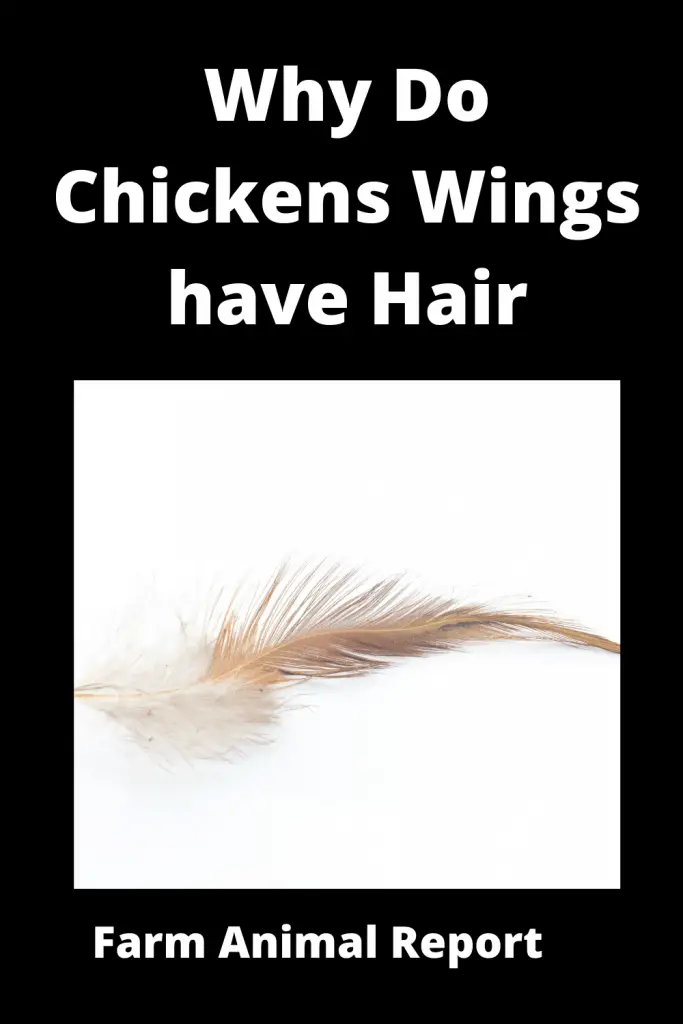
Chickens can lose a feather at any time and grow a new one, but new feathers are more plentiful during the molting period. The age of a chicken has nothing to do with whether a feather is mature.
On both sides of the shaft are rows of barbs, and on each barb are rows of barbules. The barbules have tiny hooks along the edge that lock them to their neighbors to make a smooth feather. When chickens preen themselves, they are smoothing and locking the feather barbs together.
Feathers grow out of follicles in the chicken’s skin. Around each feather follicle in the skin are groups of tiny muscles that allow the feather to be raised and lowered, allowing the bird to fluff itself up.
The color of feathers comes both from pigments in the feather and from the way the keratin that forms the feathers is arranged in layers. Blacks, browns, reds, blues, grays, and yellows generally come from pigments.
Iridescent greens and blues usually come from the way light reflect off the layers of keratin. The way the light reflects off the feather is similar to the way light reflects off an opal or pearl. Male chickens generally have more iridescent colors.
What is the Structure of the Feather?
Feathers are long and thin with a stiff hollow quill supporting the barbs of the feather. The barbs are either soft and fluffy in insulating feathers like down or locked together with hooks in the flight and tail feathers.
It is important for the feathers to be relatively broad, with a web of good firm texture, a strong shaft, the barbs, barbules, and barbicels closely and tightly knitted together. This is the desired feather type for most breeds. There are some exceptions, like the silkie which has no quill in the feather.
How Long are Feathers?
On a chicken, they vary from 1 cm to 25 cm or even more. The tails of the Yokohama may be over a meter in length. On the average bantam, they are 2 to 5 cm and for large fowl, 5 to 15 cm. Wing, hackle, and tail feathers are longer whilst the contours are shorter.
What about the Green Sheen on Feathers?
The green iridescent sheen on black feathers is much desired in the show world. Feather color is produced by arrays of pigment-bearing organelles called melanosomes. Iridescence happens when the melanosomes are organized in stacked layers and they appear to shimmer in the sun. This iridescence is widespread in birds and is frequently used in courtship displays.
Some say the green sheen is a signal of good health and the purple is a sign of nutritional deficiency in chickens. The amount of green sheen varies between chickens so some have more than others.
Mostly it is found in roosters, but hens can have it too. I have seen some beautiful sheen on the wings and body of very dark hens. Sheen is more apparent in the sun where light can reflect from the feathers. It can be selected for in a breeding program like any other characteristic.
How do Chickens Make Feathers?
They grow from follicles in the skin in a similar fashion to hair but stop when they reach the right size and don’t grow continuously like hair or fingernails.
Feathers are made almost entirely of a protein called keratin. Beaks and claws are also made of keratin as well and so are your fingernails and hair.
Keratin contains several amino acids in its make-up including cysteine, lysine, proline, and methionine.
Do They Have the Same Number of Feathers in Every Area of Their Body?
What Are Brood Patch Feathers?
No. All chickens have a bald patch under their wings and hens have a brood patch on their breast area. Only the hens have a brood patch, the cockerels don’t need one. It is to allow the warmth to be transferred from the hen to the eggs when they are sat on eggs.
Feathers are excellent insulators and the eggs would become cold if they weren’t directly against the skin. For the most part, they do. Smaller or bantam chickens have fewer and smaller feathers.
Meat chickens are bred to have fewer feathers to make for easier plucking.
What are Down Feathers?
These are the fluffy-looking ones on the underside of the bird. Most body feathers have a downy section toward the base to provide insulation.
Do Chicks Have Feathers?
Chicks begin to grow feathers from about day two or three and it can take six to eight weeks to fully feather a chick.
Why Do Some Have Feathers on their Feet?
Some birds have feathery legs and feet due to a genetic quirk. They are purely for show and it makes no difference to their ability to lay eggs. It does mean they often get dirty feet and scratchy feathers that get discolored.
What are Frizzles?
Frizzles are chickens with genetically out-turned feathers. They have been around a long time. Normally a bird with a feather mutation like this would never survive in the wild as they cannot fly and the feathers don’t trap the warmth or keep out the weather.
Chicken / Poultry Breeder Associations
| Rabbit Association | Location | Link |
|---|---|---|
| US Poultry & Egg Association | United States | USPA |
| American Poultry Association | California | APA |
| Ohio Poultry Association | Ohio | OPA |
| National Chicken Council | United States | NCC |
| British Poultry Council | United Kingdom | BPCE |
| Poultry Club of Great Britain | United Kingdom | PCGB |
| Association of Poultry Breeders in EU | Europe | AVEC |
| Australian Chicken Meat Federation Inc | Australia | ACMF |
| Australian Poultry Hub | Australia | Poultry Hub |


